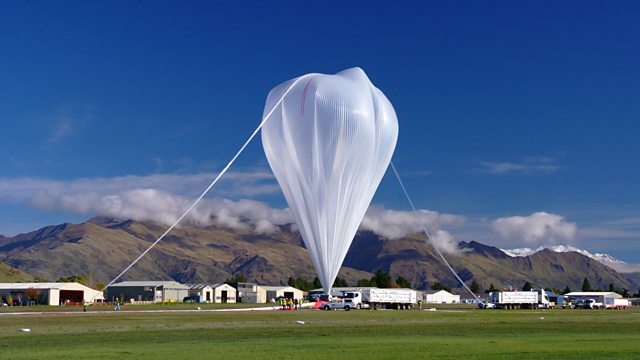Balloons and How they Changed the World
Balloons and the importance of their impact on human affairs: from adventure and war to launching satellites and life-saving surgery.
A small toy balloon floating free into the sky. A giant hot air balloon filled with passengers peering down at the ground. Classic images, but what about the huge balloons now being developed to help us explore outer space? Or the tiny balloons which bio engineers inflate inside your body to help blood surge through your veins? Or the extraordinary balloonomania that spread across Northern Europe in the late 18th century? Bridget Kendall explores the colourful history of the balloon and its even more intriguing future with guests:
Debbie Fairbrother, Chief of NASA’s Balloon Programme Office.
Professor Claudio Capelli, cardiovascular engineer from the Great Ormond Street Hospital for Children in London.
Fiona Stafford, Professor of literature from Somerville College, University of Oxford.
Photo: NASA’s super pressure balloon is designed for long-duration flights at mid-latitudes to provide scientists and engineers with a means to inexpensively access the ’near-space’ environment for conducting research and technology test missions. The balloon’s operational float altitude is 110,000 feet (33.5 kilometers) (Credit: NASA/Bill Rodman)
Last on
Clip
-
![]()
Human beings flying for the first time
Duration: 01:08
Debbie Fairbrother
Chief of the NASA Balloon Programme Office (BPO). She is
responsible for management of the NASA Scientific Balloon Programme Office, and
the Columbia Scientific Balloon Facility located in Palestine, Texas.
She is an
Associate Fellow in the American Institute of Aeronautics and Astronautics, and
has received several NASA awards for her ballooning activities.
Dr. Claudio Capelli
Research fellow at the
UCL Institute of Cardiovascular Science in the Clinical Cardiovascular
Engineering Team at the Great Ormond Street Hospital for Children. His research
employs experimental and computational techniques and 3D printing technology to
model cardiovascular diseases and devices and to study the function and
performance of the heart. He Investigates devices, such as catheter balloons,
used during cardiovascular procedures including angioplasty and examines how
these devices work under realistic working conditions using computer modelling.
You can see one of his simulated images in the gallery on the right-hand side of this page.
Prof. Fiona Stafford
Professor of English Literature at Somerville College,
Oxford, where she studies English, Irish and Scottish Romantic poetry and
literature. Her current interests include research into William Wordsworth’s
Lines written a few miles above Tintern Abbey in the UK, the literary
significance of rivers, the difference between landscape and place, and the
links and contrasts between English, Irish and Scottish literature.
Whilst
researching an early romantic literature project, Fiona came across many
references to balloons and became fascinated by the ‘balloonomania’ raging
across France and Britain that was reflected inÂ
the literature and poetry of the time.
Broadcasts
- Mon 8 Aug 2016 04:06GMTÂ鶹ԼÅÄ World Service Americas and the Caribbean
- Tue 9 Aug 2016 08:06GMTÂ鶹ԼÅÄ World Service except News Internet
- Tue 9 Aug 2016 23:06GMTÂ鶹ԼÅÄ World Service except News Internet
Do you use US dollars even though they are not your country’s official currency?
Podcast
-
![]()
The Forum
The programme that explains the present by exploring the past




